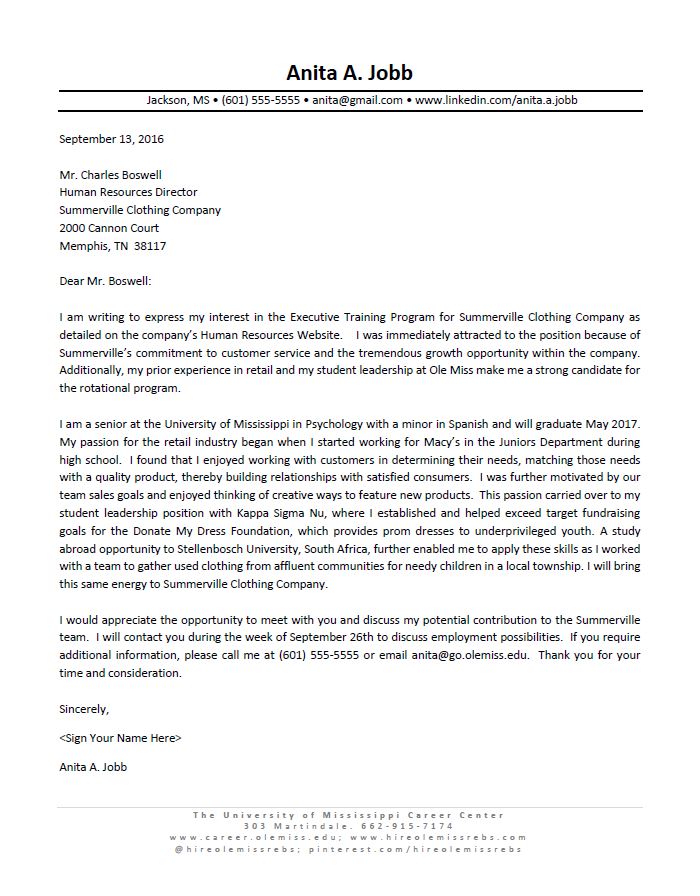What is a Cover Letter?
A cover letter is a document accompanies your resume. The purpose of this letter is to match your skills, education, and experience to the employer’s needs and to express your interest in the position and the company or organization. Never send out a resume without a well-designed, position-specific cover letter!
Cover Letter Format
The formatting and content of your cover letter is very important. A well-written, organized, and tailored cover letter can grad the attention of a potential employer. A cover letter should not simply repeat what is on your resume; instead, it should provide deeper, more specific, details about why you are perfect for that position.
- Formatting
- The top of your cover letter should have the same heading as your resume and references.
- Use 11-12 point font, Times New Roman.
- Left justify the entire document.
- Use standard business format which includes the date, employer name and title, company information, company address, and professional greeting.
- Pay close attention to appropriate spacing!
- Your cover letter should only be 1 page.
- Do not reduce margins to less than 0.5″ because, when printed, it can cut off parts of your cover letter.
- Sharing your Cover Letter
- Once you are finished, save a copy of your cover letter as a PDF document so your formatting does not change when you submit it online
- When you print your resume, make sure to print it on nice resume paper in white or off-white. (You can print on resume paper in the Career Center for just 10 cents a page!)
- When you print your cover letter, use a laser printer so there are no unwanted lines or streaks.
- Never fold or staple your cover letter.
Guidelines for Writing Cover Letters
- Include a cover letter even if you are emailing your resume to an employer.
- Always address the letter to a specific individual. Call HR to request the name of someone on the hiring committee if you cannot find one online. If you are unable to find a specific name, use “Dear Hiring Manager,” “Dear Committee Chair,” or “Dear Selection Committee,” etc. Never write “To Whom it May Concern” as it sounds cold and impersonal.
- It is best to have a position posting in front of you when you write the cover letter so that you can tailor your letter to the needs of the company as expressed in the posting.
- Research the employer prior to writing the letter. Tell them why you want to work for them!
- Be confident and positive (market yourself), but be careful not to sound arrogant.
- Provide examples of experiences/qualifications you have that make you well-suited for the job.
- Avoid phrases like “I think I am fit for this position…,” instead, say “I believe I am” or “I know I am.”
- Follow the content and paragraph structure listed below.
What to Include on Your Cover Letter
Your cover letter should clearly and concisely highlight your most valuable experience to your employer. Follow the provided paragraph structure to write your cover letter.
The First Paragraph
The first paragraph simply tells what position you are applying for and how you learned of the position.
- If you know someone at the company, or if someone referred you, be sure to mention it in your first paragraph in order to catch the reader’s attention.
- You could also state why you are interested in the position or what attracted you to the company (to show that you have researched the company.)
The Second Paragraph
This one is a little harder, but you basically want to tell the employer why they should hire you!
- Focus on what you can do for the company instead of what the company can do for you.
- Describe your accomplishments, previous experience, and job-specific skills. (You can use one or two paragraphs for this section.)
- Be selective. There’s no need to restate everything that is on your resume.
- A good tip is to look at the qualifications listed on the position announcement, then make sure you respond to each qualification listed.
- You are establishing your case for an interview so indicate at least three accomplishments that fit directly with what the employer is looking for. Focus on what you can do for the company instead of what the company can do for you.
The Last Paragraph
This paragraph closes the letter and does four things: 1) Requests a meeting or interview a the employer’s convenience; 2) Offers a follow-up date that you will get in touch with the employer; 3) Invites the employer to contact you with questions (include phone number and e-mail address here); and 4) Thanks the employer for his/her time and consideration.
- You may state that you will be in the area during a specific period of time and will make contact with the employer when you arrive in that city.
- You may take an aggressive approach by indicating a specific week in which you will contact the employers to follow-up. For example, “I will contact you the week of April 12 to schedule an interview.”
- Allow the employer enough time (1-2 weeks) to review the resume before you follow up.
- Always put a hand-signature on your cover letter.
